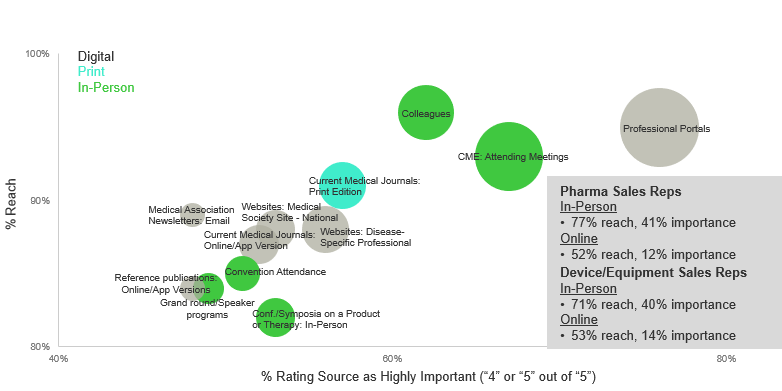Medical sales representatives fulfill a unique role in hospital and office settings, using the effectiveness of personal interaction to educate and update doctors and other HCPs in the quest for drug/device/procedure adoption and, ultimately, sales. Likewise, pharma and device marketers have relied heavily on dinner meetings, conference presentations and commercial exhibits, and other in-person channels to bring new information to HCPs and keep their product message top of mind. With the COVID-19 pandemic uprooting the lives of all individuals and severely limiting non-essential personal interaction, the question for sales reps and marketers becomes how best to reach medical audiences at a time when credible and timely information is critically important.
A first impulse may be to dust off e-detailing plans. However, a recent Kantar study indicated that participation in e-details was low - with 62% of doctors saying they had either never participated in an e-detail or hadn’t participated in the past six months - and that from a physician perspective, online details were much less effective than in-person.
Effectiveness of in-person versus online detailing – the doctor’s perspective

This data suggests a combination of channels is more effective for quickly disseminating the necessary information to all relevant HCPs and maintaining sufficient frequency of exposure for brand messaging. Kantar’s 2019 research into physician use and reliance on a range of traditional and digital information sources offers perspective on which promotional channels could be most useful in terms of engaging HCPs, both generally and at unexpected moments like now, when personal promotion is heavily restricted.
Physicians’ Top Information Sources (Among 46 Different Channels)

For comparison, when it comes to staying well-informed about medical developments, doctors rate in-person pharma rep meetings in the top 20 among 46 information sources, while online meetings with pharma reps is at the very bottom.
Nine out of ten doctors consider current issues of medical journals to be among their most important information sources, and they access both print and digital platforms: 91% are reachable via print and 87% read online. In addition to standard advertising options, print publications offer a unique means of getting already-approved and produced print materials into the hands of the right doctors. Whether sales-rep leave-behinds or materials previously destined for commercial exhibits at a conference, most magazines accept pre-printed sales material as inserts or outserts, and many can target these to smaller portions of their circulation to align with available quantities.
Digital platforms clearly play a central role in an effective HCP advertising plan. Online clinical decision resources and web portals, as well as medical association and medical journal sites, should be core elements in any communication strategy due to universal reach, frequent visitation, and credible content. Digital has evolved in terms of available channels and production quality, and doctors have steadily increased their usage of other digital platforms for various e-learning and information gathering experiences.
Three-quarters of physicians surveyed in the Kantar research said they utilized instructional videos and two-thirds indicated they listened to non-CME medical podcasts or webinars/webcasts. Even virtual/augmented reality is gaining traction among doctors as a method for e-learning. Any of these channels could be an effective avenue for delivering information (especially more long-form, educational content) to HCPs in the absence of meetings or personal visits from pharma and device reps.
Email newsletters are a proven tool for reaching HCPs. However, fewer than 1 in 5 doctors surveyed consider online mailings or newsletters from pharma or device companies to be important or very important to their practice. A better communication strategy for marketers might be to sponsor or advertise in third-party newsletters that doctors already read and trust. Not all newsletters offer this option (government or university bulletins, for example), but there are plenty of commercial and medical society newsletters that are distributed frequently to clearly defined, validated HCP audiences to meet specific targeting needs.
Professional social networks deliver lower ratings on perceived importance as an information source (only about 1 in 5 doctors rate them as important/very important) and offer more limited reach than some of the other digital platforms (only 2/3 of physicians use professional social networks). However, they offer a unique benefit: high usage frequency (4th among all the studied information sources). It appears that those that do utilize social access it regularly. As sponsors or content providers, adding social along with more high-reach/high-credibility but lower-frequency channels could help marketers round out their media mix.
What the Kantar data makes clear is that while no single channel can completely replicate benefits of in-person promotion, there are a range of communication channels that, used in combination, can effectively educate and deliver product information to HCPs during the COVID-19 crisis.
For additional insights into channel preferences across 26 physician specialties and additional medical audiences, as well as detailed media consumption metrics for over 1,000 professional websites, mobile apps, social networks, and medical journals, download our latest study Content Directory here.
Data cited in this article:
- Kantar Medical/Surgical Physician Sources & Interactions Reports, 2018 and 2019 studies.
- Kantar Media Medical/Surgical Digital Insights Report, 2019 study.
Contact us for more information.
